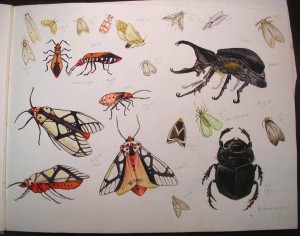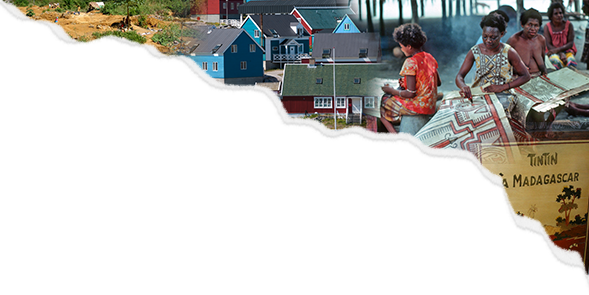Graphic Adventures in Anthropology
This is the second post in a new blog series called Graphic Adventures in Anthropology. Once a week for 7 weeks, a guest contributor will write about some aspect of graphic anthropology (and by “graphic” we mean drawing in general, and comics in particular), from visual culture to visual communication, and from ethnographic method to dissemination device, culminating in the announcement of a new series we are launching at the press called ethnoGRAPHIC. Here’s the line-up:
Andrew Causey: Drawing as an Ethnographic Method
Stacy Leigh Pigg: Learning Graphic Novels from an Artist’s Perspective
Sherine Hamdy & Mona Damluji: Reflecting on Arab Comics: 90 Years of Visual Culture
Coleman Nye: Teaching Comics in a Medical Anthropology & Humanities Class
Gillian Crowther: Fieldwork Cartoons Revisited
Juliet McMullin: Comics in the Community
Nick Sousanis: Unflattening Scholarship with Comics
Anne Brackenbury: ethnoGRAPHIC: A New Series by University of Toronto Press
See last week’s blog posting here.
“You’ve got to draw it if you want to see it”: Drawing as an Ethnographic Method
By Andrew Causey, Associate Professor of Anthropology, Columbia College Chicago
(Columbia College is a private arts, media, and communication college in downtown Chicago. Andrew is one of two full-time anthropologists in the Humanities, History, and Social Sciences Department, and is committed to introducing non-majors to issues of world art and cultural visualities, hoping to bridge perspectives from the arts with those of anthropology. In addition, Andrew is a practicing artist and musician.)
My teacher Linda Schele said those words to me years ago when teaching me about the iconography of ancient Maya sculptures. She’d given me an assignment: to make sense of the carved stone monuments from the ancient site Quirigua, in south-east Guatemala. All I had were photocopies of Alfred Maudsley’s 1880s photographs, and I was having trouble distinguishing meaningful elements from the convoluted Baroque tendrils and curls on these elaborate carvings. I brought my photocopies to her house, and the first thing she did was put one on a light-box, taping a sheet of tracing paper on top, saying, “You’ll never see a thing just staring at it on paper! You’ve got to draw it if you want to see it.”
She began following the contours of the figure’s head, showing me how to lift the tracing paper to make sure the lines followed properly. She handed the pencil to me, and she was right: as soon as I began to draw it, I began to see it.
Schele’s not the first to insist that to truly see something we must draw it. Surely John Dewey and the pragmatists would have encouraged such acts as their learn-by-doing credo; Rudolf Arnheim supported this notion in his book Visual Thinking, saying, “to make an object visible means to grasp its essential traits” (1969:254). John Berger noted that drawing is immediate in its reckoning of the real and fleeting moment, allowing us to “challenge disappearance” (1985:149), and helping us to reconsider the act of drawing. But in terms of practical engagements with line drawing, the most influential works of the past decades are probably Betty Edwards’ Drawing on the Right Side of the Brain (1979) and Drawing on the Artist Within (1986). In the latter book, Edwards explores the notion that drawing is actually a system of seeing with precision, noting that too often the product (the drawing) takes precedence over the process (the act of actually seeing deeply).
Both anecdotal evidence and careful academic research seem to indicate that taking notes by hand, and by extension making visual notes via drawing, engage the brain in a way that increases cognitive processes and memory (see for example, Mueller and Oppenheimer 2014). In my own ethnographic research in North Sumatra, Indonesia I found that I gained appreciation of the entomological world around me by collecting and then drawing moths I found, as a hobby; upon seeing these drawings, my carving teacher introduced me to aspects of Batak culture that I would not have discovered otherwise (Causey 2012).

A page of my drawings of bugs that I found around my home in North Sumatra, some of which prompted my carving teacher to share cultural information unobtainable otherwise.
I teach at a college where most students get undergraduate degrees in the arts and communication fields. Because so many of them are working with different kinds of visual materials, I always assumed they also knew how to perceive carefully. After about six years of teaching a course called Visual Anthropology (addressing a variety of visualities, from world art to symbol systems and representation), I grew increasingly frustrated about their seeming contentedness to look only at surfaces.
Finally, impatient with their inability to see figures on a Maya painted vessel—even when I was pointing out the features on the screen—I photocopied the vase’s image using high contrast. Remembering the advice of Linda Schele, I asked them to draw directly on the paper, following the contours. One by one, I could see the students perceive the figures as they popped into view. What I realized: I had to teach them how to see… not just Maya kings in complex surroundings, but also the world around them.
The more I’ve thought about it, the more I think that many anthropologists may not “see” very well, either. I don’t say this as a critique, but as an observation of the social worlds we come from. First, to succeed, we are increasingly required to make sense of our visual surroundings by skimming, scanning, glancing, and browsing: the faster the better. Second, while ethnographic fieldworkers are taught to carefully observe, their observations are ordinarily translated into words—as they think and as they write. Perhaps these two aspects result in limited perception, and so, in limited understanding. If Arnheim, Berger, Schele, and Edwards are right, then to see more clearly we may need drawing to help us.
I continue my search for texts to help me teach students to see. James Elkins’ The Object Stares Back: On the Nature of Seeing (1996) gives vital inspiration to reconsider what it means to perceive the world. He also provides us the phrase “visual literacy” to stress the importance of seeing as an essential ingredient of education (Elkins 2008).
More recent works promote the use of line drawing as a legitimate ethnographic method. Michael Taussig discusses the importance of delineation in his recent work I Swear I Saw This (2011), describing several situations where line drawing (that is, its active process and the information it conveys) revealed new ethnographic understandings of the visual environment. In my own ethnographic work, similar situations arose: in attempting to draw women hoeing their dry fields, local Bataks criticized my depictions, yet also provided valuable information about how the hoe is held, how the women wrapped their fabric head-cloths and back-saving sarongs around their waists, and how they positioned their feet as they moved across the field breaking up the soil.
Tim Ingold’s research—such as his ground-breaking Lines: A Brief History (2008), which considers human experience as threads and traces, and his more recent edited volume Redrawing Anthropology: Materials, Movements, Lines (2011), which explicitly calls for a focus on drawing (in the broadest sense of making linear movement visible), also suggest avenues to more innovative research. Cartoonist Lynda Barry might guide the way: her new book Syllabus (2014) provides us with some practical exercises for seeing-drawing.
I suppose it’s time for ethnographers to take action—not simply ponder the possibilities. Let’s start making lines, and by doing so teach ourselves (or let others instruct us) to see more deeply and richly.
Sources:
Arnheim, Rudolf
1969 Visual Thinking. London: Faber and Faber Limited.
Barry, Lynda
2014 Syllabus: Notes from an Accidental Professor. Montreal: Drawn and Quarterly Press.
Berger, John
1985 “Drawn to That Moment,” in The Sense of Sight. New York: Pantheon Books.
Causey, Andrew
2012 “Drawing Flies: Artwork in the Field,” Critical Arts: South-North Cultural and Media Studies, 26 (3):162-174.
Edwards, Betty
1979 Drawing on the Right Side of the Brain. NY: Tarcher.
1986 Drawing on the Artist Within: An Inspirational and Practical Guide to Increasing Your Creative Powers. NY: Fireside Book.
Elkins, James
1996 The Object Stares Back: On the Nature of Seeing. New York: Harvest Books.
2008 Visual Literacy. New York: Routledge.
Mueller, Pam A. and Daniel M. Oppenheimer
2014 “The Pen is Mightier than the Keyboard: Advantages of Longhand Over Laptop Note Taking,” in Psychological Science, June, 25:6:1159-1168.
Taussig, Michael
2011 I Swear I Saw This: Drawings in Fieldwork Notebooks, Namely my Own. Chicago: University of Chicago Press.



